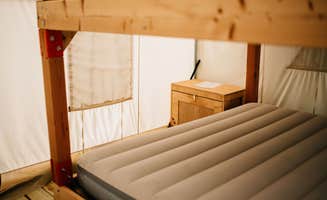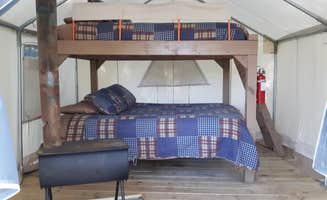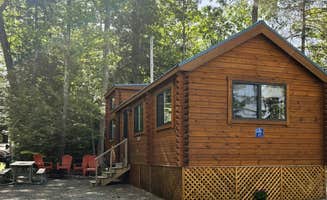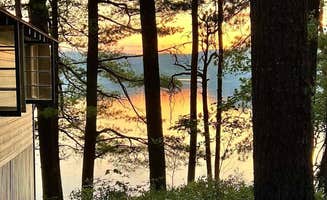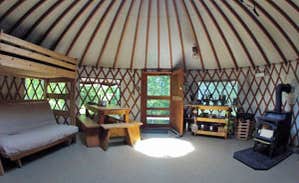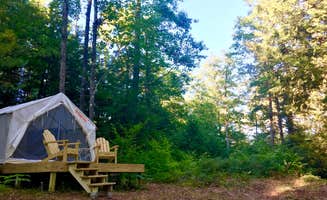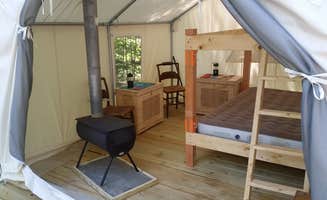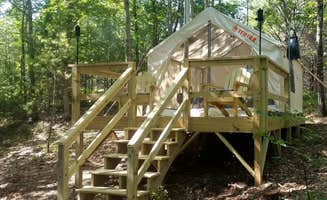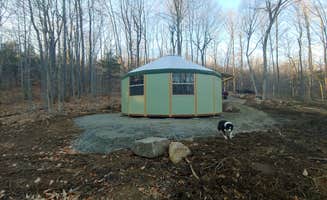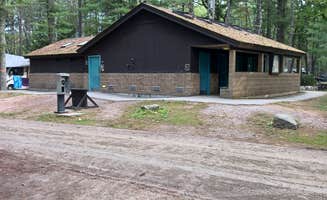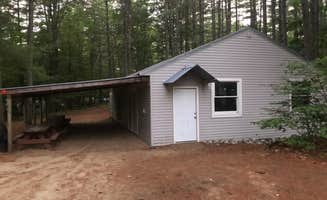Camping around Bridgton, Maine centers on lake country, with over 30 bodies of water within a 15-mile radius. The region sits at approximately 400 feet elevation in the foothills of the White Mountains, creating a microclimate that extends camping seasons slightly longer than coastal Maine areas. Summer temperatures typically range from 70-85°F during day and 55-65°F at night, making sleeping conditions comfortable for tent and yurt campers.
What to do
Water activities on Trickey Pond: The pond offers exceptional clarity and calm waters for paddling. At Loon's Haven Family Campground, visitors experience what one camper called "the cleanest pond in Maine" where "the pond is crystal clear and beautiful." Another guest mentioned "we boated over to one of the small islands to find a rope swing which provided entertainment and memories for my children."
Hike Pleasant Mountain: Located just minutes from several campgrounds, this moderate 3.6-mile trail offers panoramic views of the lake region. A camper at On the Saco Family Campground shared: "Camping for the night before the hike to the summit of Pleasant Mountain! Beautiful campground, super friendly owners, amazing Saco River access." The trailhead is accessible from Route 302, with parking available at the base.
River tubing on the Saco: The gentle current makes this perfect for families with younger children. Tube rentals typically cost $15-25 per person. As one camper noted, "We took a shuttle up with some kayaks, reasonably priced, and drifted back down 10 miles right to our site!" Many campgrounds offer direct river access and equipment rentals from late May through early September.
What campers like
Private wooded sites: Many campgrounds offer secluded spots among tall pines that provide natural separation. A visitor to Papoose Pond Family Campground and Cabins mentioned: "We were on the pool/rec hall side and it definitely seemed less condensed over there than the pond side. The campsite was large and private with good distance between the next sites." These wooded sites typically cost $5-10 more than standard sites but offer more seclusion.
Wildlife viewing opportunities: Early mornings and evenings present the best chance to see native wildlife. According to a camper at Lakeside Pines Campground: "Loons loons everywhere. Lots of wildlife. Good facilities." Many campers report seeing loons, eagles, herons, and occasionally moose or deer, particularly in less developed camping areas.
Family-friendly atmospheres: Most campgrounds prioritize creating engaging environments for children. A guest at Acres Of Wildlife Family Campground shared: "A must! This camp ground is FULL of fun for kids. There is activities and 2/3 playgrounds." Another visitor noted, "I had a lot more fun than I thought I would—definitely going back!"
What you should know
Site spacing varies significantly: Waterfront sites tend to be closer together while wooded sites offer more privacy. One camper at Sebago Lake State Park Campground observed: "This campground was in the woods and was well maintained. The campsites definitely felt like they were on top of each other and are pretty small." Another noted, "We picked a medium one and could barely fit 2 tents and 2 cars with a safe distance from the fire. 2 sites were within 15ft of our fire pit."
Seasonal operation limitations: Most campgrounds operate from mid-May through mid-October, with peak season running late June through late August. Reservations for summer weekends should be made 3-6 months in advance. Some facilities like bathhouses and camp stores have reduced hours or services in May and October.
Yurt camping options: Several campgrounds near Bridgton offer yurt accommodations for those seeking a glamping experience. Yurts typically include beds, electricity, and sometimes kitchenettes. Two Lakes Camping provides yurt rentals from May through mid-October, with prices ranging from $95-135 per night depending on season and amenities.
Tips for camping with families
Look for campgrounds with organized activities: Daily programs provide entertainment beyond swimming and hiking. One visitor to Two Lakes Camping shared: "I went here once with my family. Sure cute beach area and loved that we could do ceramics. They had a wild west party and we got to dance and have a campfire in a huge field. It was cute!"
Choose sites near bathrooms but not main roads: This balances convenience with noise control. Many campgrounds have high traffic areas that stay busy until quiet hours begin, typically 10-11pm. Sites along main campground roads experience more foot and vehicle traffic throughout the day.
Bring water shoes for lake and river access: Many natural shorelines have rocky entries. Most beaches at campgrounds are natural rather than maintained sand. Children particularly benefit from protective footwear when playing in the water.
Tips from RVers
Campground roads can be challenging: Narrow access roads with tight turns require careful navigation. A visitor to Eastern Slope Camping Area noted: "Big RV will have trouble maneuvering in here because it is tight." Another warned, "Sites are really close together and hard to maneuver a RV into."
Extension cords and hoses recommended: Hookup locations aren't always conveniently placed. One camper advised: "Be sure to bring extensions for electrical and sewer as a lot of sites are set up with difficult connection spots." Most campgrounds provide 30-amp service, with 50-amp available at select sites for an additional $5-10 fee.
Weather considerations for spring and fall camping: Be prepared for temperature fluctuations and possible flooding in low-lying sites. During heavy rain periods, some campgrounds experience water accumulation in certain areas. A camper mentioned that "when it rains it floods the sites near the bathroom toward the beginning of the entrance."


